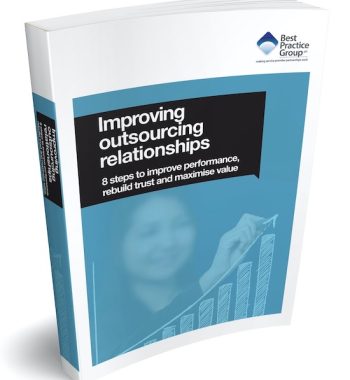 With so many pieces in play on the metaphorical chessboard of complex service-provider relationships, to ensure success in achieving your business outcomes it is important to know how each will move. Who are the advocates, the obstructers and the fence-sitters? How will they act and react throughout the time span of the relationship, and how can you make sure that as many stakeholders as possible are pulling in the right direction? Although the art of stakeholder management is complex because you are dealing with personalities and, often, with political agendas, it is possible to influence and guide those with an interest in your service delivery.
With so many pieces in play on the metaphorical chessboard of complex service-provider relationships, to ensure success in achieving your business outcomes it is important to know how each will move. Who are the advocates, the obstructers and the fence-sitters? How will they act and react throughout the time span of the relationship, and how can you make sure that as many stakeholders as possible are pulling in the right direction? Although the art of stakeholder management is complex because you are dealing with personalities and, often, with political agendas, it is possible to influence and guide those with an interest in your service delivery.
Learning how to manage stakeholder relationships and interactions is crucial if you wish to smooth the path to achieving your business objectives. With so many differing vested interests involved, it is essential that your organisation becomes proficient at defining and delineating different groups of people, based on their influence and interest in each specific outcome. We hope this article will help support your own thinking to navigate the often abstract field of stakeholder management, enabling key stakeholders to champion your cause and thereby generate maximum value in your service delivery.
Why is stakeholder buy-in so important?
If you wish to maintain successful business outcomes in complex service-delivery relationships with your vendors, it is essential that you have the appropriate influential vendors and internal stakeholders on side from the outset. No one can complete the job on their own. Even if your CEO has talked up a service partnership and its integral importance to the organisation, you cannot guarantee that your objectives will be achieved on time, or even at all, without having the support of appropriate internal and external stakeholders.
Without these influential individuals on side – whether they are internal project team members or community leaders with a vested interest in the outcome of the project – it is possible that they may prioritise the protection of their own interests over and above those of the relationship as a whole, not only causing delays and the budget to spiral out of control but, ultimately, a failure to achieve the outcomes you need.
For example, if vital work needs to be carried out on a public building, there may be some locals who will attempt to limit the number of hours that builders can work. While noise may be a valid issue, delays due to shorter working hours will add to the length of the project and impact on project costs. It is therefore vital to have these local stakeholders on side. They can then recognise that finishing the project as quickly as possible is more important than any disruption it may cause in the short term.
Understanding your stakeholders
You will know from your own experience that predicting the actions of your stakeholders is vital if you wish to manage them effectively. In order to understand and ultimately influence your stakeholders, there are five key things that you need to consider.
1. What are your stakeholders’ political leanings?
With so many stakeholders, often from different backgrounds, involved in the same project, it is essential that you are aware of the effects their political views may have. Stakeholders are likely to offer more help for projects that align with their viewpoint. Consequently, there are likely to be different ways you can engage with them to attract their support, depending on their political leanings.
2. What are your stakeholders’ aspirations?
Knowing what your stakeholders want out of a project, both in the short and long term, can greatly affect your ability to help them influence your cause. As well as their aspirations, it is also useful to know what their prejudices are to avoid offending them.
3. How does your organisation view its stakeholders?
Opinions vary among organisations as to the degree it is deemed acceptable to influence stakeholders. Therefore, it is essential to have a business strategy in place to ensure that your team members are all on the same page. Some organisations believe that stakeholders are there to be controlled for the good of the project, while others believe that you can take this too far and that stakeholders should be left to make up their own minds. Your organisation must determine its stance, but it is also worth noting that some stakeholders may not react well to attempts to influence them.
4. How influential are your stakeholders?
Understanding the levels of influence that key stakeholders have within a particular project is crucial if you wish to see the project through. Since stakeholder influence can have either a positive or negative effect on your project, it is important to have the more influential stakeholders on side. Then they can help to influence the nay- sayers.
5. How should you approach stakeholder influence?
Within a management team it is important to have an overarching agreement regarding how you can ask your stakeholders to champion the best interests of the project. Some organisations choose to suggest voluntary actions, while others ‘lay down the law’ and demand that actions are carried out. It is therefore essential to get to know your stakeholders in order to recognise which approach will achieve the desired results.
How to group your stakeholders effectively
With the above five points in mind, grouping and mapping your stakeholders according to their level of influence within a specific project is vital if you want them to champion your cause. Visualisation charts are an excellent way to do this, allowing you to group stakeholders in a variety of ways. First, it is important to group them according to the power that they may exert upon the outcomes to be achieved, particularly if you have identified someone who could completely shut down a project if they should wish to. For an easy guide to how much influence stakeholders wield, it is useful to place them on a sliding scale of 1 to 5, with 1 being the least powerful and 5 the most.
After your team has identified the most influential players, it is advisable to create an engagement plan that gives special attention to the top 10 or 20 stakeholders, depending on the size and strength of the stakeholder pool. Detailed profiles should be created for these top individuals, including their attitude towards the project, as well as all the information gleaned from the five points above. The more information you gather at this stage, the greater your chances of the stakeholder championing your cause. These detailed profiles can then be kept on file for future projects, helping you to maintain relationships with these key people in the future.
Once you have made first contact with these stakeholders, it is critical that you stick to a rigid communication plan and keep notes on all of your meetings and exchanges, so that any issues can be brought up in regular stakeholder engagement reviews with the rest of the project management team. The process of stakeholder engagement should also be written into the core of your project plan, especially if you have identified stakeholders that could throw the whole project off course if they chose to.
Five headline steps to effective stakeholder management
Managing and influencing key stakeholders is crucial to the success of any service- delivery partnership within the private or public sector. Not only will effective stakeholder management help you to see your project through to completion, it will save you a considerable amount of time, money and resources in achieving fit-for-purpose business outcomes.
In summation, here are five headline steps to follow to make the most of your stakeholder relationships.
1. Get to know your stakeholders – What are their views, opinions, aspirations and prejudices? Regular, informal catch-up discussions over coffee are the key. Genuine trust needs to be built by helping stakeholders to achieve their goals before expecting them to help you achieve yours.
2. What do they want from the relationship? – If you know what outcomes a stakeholder is seeking from a service-delivery relationship, then it will be much easier for you to persuade them to champion your cause.
3. Identify the most powerful influencers – Using visualisation mapping and sliding scales, identify which stakeholders have the most power and influence within your project.
4. Create a detailed engagement plan – Decide the best way to approach each of your top 10 to 20 stakeholders to help them achieve their own goals, and keep records of all meetings for future use.
5. Hold regular stakeholder engagement reviews with your team – This is in order to make sure all members are on the same page. Review your stakeholder relationships regularly throughout the project/relationship and routinely assess and reassess your strategy. Remember, it’s during the informal and regular engagements over coffee when the most effective stakeholder work is accomplished, not at the boardroom table.
For a more in-depth analysis of how to build and maintain a successful relationship with your service provider, see our Strategic Commissioning white paper.

